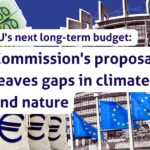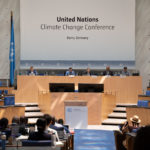Civil society’s proposal for putting Europe’s energy transition back on track
By Jörg Mühlenhoff and Jonathan Bonadio
Published in energypost.eu
Jörg Mühlenhoff, Energy Scenarios Policy Coordinator, Climate Action Network (CAN) Europe
Jonathan Bonadio Policy Officer on Renewables, Climate and Grids, European Environmental Bureau
Europe’s energy landscape can become fully renewable and cut greenhouse gas emissions by 65% by 2030 with proven technologies and available solutions, as a truly Paris Agreement compatible civil-society-led energy scenario shows. This is the first EU scenario for net-zero emissions in 2040 and is the result of a collective research process by more than 150 stakeholders from NGOs, industry and science, led by Climate Action Network (CAN) Europe and the European Environmental Bureau (EEB). This robust work shows that Europe can and must be more ambitious if it is serious about limiting temperature rise to 1.5°C.
EU Member States currently negotiate multi-billion euros recovery packages. It is however not yet clear if this response to the COVID-19 crisis will be used as an opportunity for winning twice: combating recession as well as reducing the risks of climate change. Not to mention the massive impacts that are already looming. The current level of greenhouse gas emissions leads the world straight into a temperature increase of at least 3°C – with unprecedented economic, social and environmental consequences.
Translated into economic benchmarks, the impacts of climate change already lead to additional costs of more than 150 billion euros per year. Europe needs a swift turnaround of greenhouse gas emission trends.
Prevention is better than cure
This health crisis teaches us that distant threats are worth preparing for. What is evident for the COVID-19 pandemic, is also valid for greenhouse gas emissions. The sooner we react, the smaller the damage. The civil society scenario developed by CAN Europe and EEB suggests a quick reduction of emissions by cutting energy demand, in particular in buildings, while scaling up renewable energy capacity, in particular through solar and wind power. This is the best recipe for squeezing out fossil fuels from the energy mix. Coal as the most polluting energy carrier is the first to leave around 2030, followed by fossil gas around 2035 and fossil oil products by 2040.
Take climate emergency seriously
Such a switch to a 100% renewable energy system seems ambitious, especially when compared to many official scenarios of the European Commission or the European grid operators, but it is indispensable for implementing what the EU and its Member States endorsed in Paris in 2015. Only last year, the European Parliament and many local governments declared “climate emergency” and with COVID-19 holding a mirror to our society and showing how fragile our systems are, there cannot be any doubt that it is time to act.
Energy savings and renewables are easily available, and the most obvious answer to the climate crisis.
The PAC scenario, a pragmatic response to climate emergency
When CAN Europe and EEB kicked off the PAC scenario building process in spring 2019, the analogy with the global health crisis naturally was unimaginable. Even without factoring COVID-19 into the equation, stakeholders involved agreed that the scenario needed to be an emergency plan. Europe does not have much time left for putting its emission reductions on track to the Paris Agreement’s 1.5°C target and this civil society Paris Agreement Compatible (PAC) scenario defines how the EU can mobilise the best available solutions as soon as possible. The emission reductions under the PAC scenario are almost exclusively based on mature technologies. These solutions are introduced into markets and can be scaled up easily.
KEY FINDINGS
1. A collective research exercise led by civil society
The key assumptions of the PAC scenario were developed between spring 2019 and spring 2020 in a series of workshops. More than 150 experts engaged in the workshops, coming from CAN Europe and EEB member organisations, from science, renewables and energy efficiency industries and from grid operators. Guest speakers presented findings from research projects to discuss key assumptions on energy demand and supply for the PAC scenario.
This highly interactive scenario building process did not only mobilise a broad expertise ranging from experienced researchers to NGOs campaigners, it also allowed for a consistent integration of the different policy demands of NGOs into the energy scenario. Boundaries such as the protection of biodiversity or sustainability of raw material supply thus were reflected in the key assumptions of the scenario. Scientists and energy experts on the other side learnt from NGOs about cross-cutting issues that were linked, but not yet considered in their research.
The PAC scenario now is backed by CAN Europe’s and EEB’s membership, representing several hundreds of NGOs with more than 47 million individual members from almost all European countries.
2. Flatten the curve of emission now
The PAC scenario is an energy scenario that is built to achieve 65% greenhouse gas emission reductions by 2030 and net-zero emissions by 2040.
The overarching target of the PAC scenario building was clear: getting EU climate ambition back on a trajectory that has a reasonable chance to flatten the curve of emissions in time. What is the pace of emission reductions needed? The recent UNEP Emissions Gap Report states that annual reductions of 7.6% between now and 2030 are required to keep the 1.5°C temperature target attainable.
3. Reducing the EU’s energy demand
After having defined the overarching principles for emissions reductions, the mere energy scenario building started with an assessment of the EU’s future energy demand. Based on existing studies and the exchange with science, stakeholders together analysed the energy savings potentials in five sectors: industry, residential, tertiary, agriculture and transport. The PAC scenario shows in detail how the EU’s final energy demand can be cut in half between 2015 and 2050.
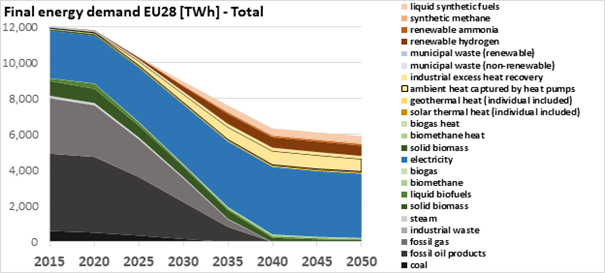
Implementing the circular economy approach
One cross-sectoral trend is fundamental for curbing the EU’s energy demand: circular economy. The evolution of raw material demand follows the principles of reducing, reusing and recycling. Improved product design and the use of secondary raw materials are promising and quick ways to make products less resource-intensive and with lower embedded energy. In particular industrial value chains can contribute to this trend.
In a broader sense, new business models and behavioural change are part of this evolution. Less energy will be consumed in the steel and aluminium industry due to more circular business models. Plastics will become highly circular materials, cutting the raw material demand and energy demand of the chemicals industry. Key findings were taken over from the circular economy scenario of the Material Economics report and a number of branch-specific assessments.

Modernising processes and products
Less energy-intensive processes are decisive for cutting the energy demand in the industry. One of the most important factors is the broad introduction of electric arc furnaces in the steel industry (70% of EU steel production in 2050). Electrification increases the efficiency of many production processes. The PAC scenario assumes that the direct use of electricity replaces inefficient burning of fossil fuels wherever possible. Renewable hydrogen and synthetic methane are mostly limited to the steel and chemicals industry. Carbon capture and storage (CCS) technologies are not considered a realistic option.
Consumer appliances and lighting need less energy. Further improvements of their energy efficiency are considered as realistic in the PAC scenario. Final energy demand of appliances and lighting annually reduces by 2.9%.
Roll out a deep renovation wave
While the industry’s final energy demand decreases by roughly a third between 2015 and 2050, much more important energy savings can be achieved in buildings. The residential sector cuts three quarters of its final energy demand for space heating and hot water due to a deep renovation wave. It implies an annual renovation rate of the EU building stock of 3%, thus tripling the current rate of ca. 1%. The PAC project takes over assumptions from the EUCalc project that shows that up to 70% of those renovations can be deep renovations that cut the energy need of buildings by 60%. Each year, 1% of the existing building stock will be replaced by newly built constructions that are highly efficient.
The PAC scenario also takes into account the potential changes in energy demand that originate from behavioural changes. Societal trends such as urbanisation tend to reduce the residential floor area available per capita to 37 m2 in 2050. As a consequence, energy demand for space heating further reduces.
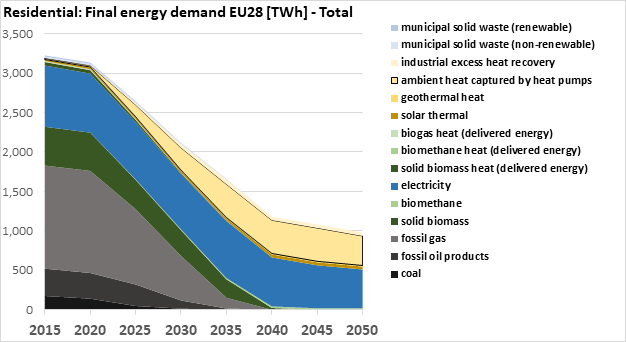
Behavioural changes however are rather difficult to model. In the case of digitalisation and home automation, they also can entail rebound effects. If the new technologies are not used in an intelligent way, energy demand might even rise. During the PAC scenario building process, participants from NGOs and science intensively discussed these risks. The PAC scenario remains cautious. It does not bet that all the theoretical maximum of savings from behavioural changes will be harvested. Literature shows that the energy savings potentials from technology changes and from new societal trends do not need to be mobilised both to their full extent for realising the PAC scenario’s pathways.
Shifting transport to more efficient modes
The remaining cars on the roads will be used more efficiently – and they will all be electrified by 2040. The PAC scenario adapts most of the trajectories described in Transport and Environment’s pathways for decarbonising the EU fleet of cars, busses, trucks, planes and ships. Research shows that goods and passengers in the future could travel even slightly more while using substantially less energy to do so.
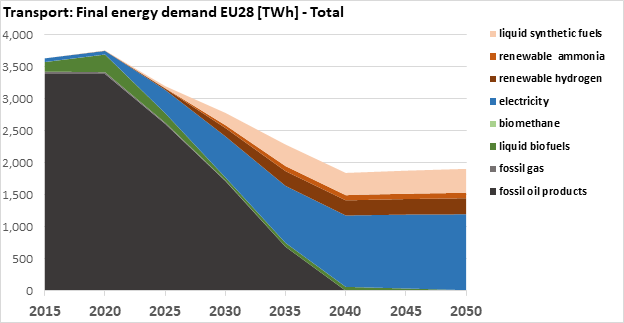
Transport activity (i.e. the product of passengers or tonnes of freight*distance) slightly increases, with annual activity growth rate ranging from 0.52% in cars to 1.67% in freight. However, the growth in travel demand will be more than compensated by efficiency gains through electrification, technical improvements, modal shift and behavioural changes. These gains will cut energy demand in half between 2015 and 2040.
The modal shift plays an important role for energy savings in the transport sector. The PAC scenario assumes doubling rail freight between 2015 and 2040, and a 12% shift from car to bus, train, walk and bicycle combined.

4. Phasing out fossil fuels and nuclear power
The most polluting fossil fuels have to disappear first from the energy mix. The PAC scenario foresees a swift phase-out of fossil fuels to reach an almost fully renewable energy supply by 2040.
Coal power plants become uneconomic by 2030
Recent analysis as well as the European-wide wholesale electricity market modelling run with PAC scenario numbers by Öko-Institut clearly prove the decline of former “king coal”. With rising renewable energy capacities and a carbon price of €84 per ton of carbon in 2030, coal power plants will only provide very limited reserve capacities during a few days per year in Poland and Germany. They inject marginal 7 TWh of electricity into the grid in 2030. Many lignite and hard coal capacities were already uneconomic before the COVID-19 crisis. The increase of solar and wind electricity generation scrunches full load hours.
Leaving fossil gas by 2035
Most of the fossil gas will leave the EU energy mix by 2035. Fossil gas-fired power plants will undergo the same development as coal plants, just with a few years of delay. Their alleged “bridge function” is barely needed according to market modelling results. Flexibility options such as demand response, more storage capacities and a quick grid expansion make most fossil gas capacities superfluous. In the PAC scenario, the share of fossil gas in final electricity demand falls from 616 TWh in 2015 to 70 TWh in 2035.
The deep renovation wave reduces heat demand of buildings, thus shrinking the classic fossil gas market. Once a building is refurbished, the PAC scenario assumes that most of the inefficient individual fossil gas boilers are replaced. Electric heat pumps or district heat networks in more densely populated areas are the first choice. While 41% of the residential sector’s final energy demand and 36% of the tertiary sector’s final energy demand in 2015 was covered by fossil gas, the share drops to 9% in 2035.
For efficiency reasons, neither renewable hydrogen nor synthetic methane are introduced for heating in buildings. Introducing hydrogen from fossil gas in combination with CCS technologies is neither considered a realistic option nor a contribution to emissions reduction.
Making fossil oil products superfluous by 2040
While fossil oil boilers are gradually substituted at the occasion of building renovation, fossil oil remains the dominating energy carrier for transport in 2030. The PAC scenario considers a phase-out of fossil oil by 2040 as realistic under the condition of a fast upscaling of electric vehicles. The aviation sector’s dependence on fossil kerosene is a challenge. As the availability of liquid biofuels remains limited, renewable hydrogen will have to be converted into liquid synthetic fuels as the only accessible alternative that brings about a climate benefit.
Few nuclear power plants remain until the 2040s
Investments into new nuclear capacities are considered as not competitive anymore. The PAC scenario does not expect any lifetime extension. On the contrary, increasing costs of maintenance, of the fuel chain and decommissioning, rather tend to incentivise earlier retirements. Only those very few reactors built after 2000 remain in the electricity mix after 2040, mainly in France and the UK.
5. Mobilising renewable energy potentials
A quick upscaling of renewable electricity generation capacities during the next decade is at the core of the PAC scenario. Mobilising wind and solar electricity as the cheapest energy sources bring the share of renewables in the EU’s gross final consumption to more than 54% in 2030 and nearly 100% in 2040.
Wind energy as the EU’s driver of electrification
The PAC scenario largely takes over assumptions on onshore wind potentials and capacity factors from the highly granular model of the Energy Watch Group (EWG) and LUT University. The quick upscaling of onshore wind electricity generation leads to a more than six-fold increase from 267 TWh to 1,829 TWh between 2015 and 2030.

Offshore wind potentials and capacity factors are based on BVG Associates and the International Energy Agency (IEA), following the European Commission’s estimation of up to 450 gigawatt of capacity mainly in the North Sea, Baltic Sea and Atlantic and to a minor extent in the Mediterranean. The PAC scenario assumes that this potential will partly be mobilised by 2040.
Solar electricity empowering prosumers
As solar photovoltaics is the cheapest and easiest to scale-up technology for end consumers, the PAC scenario assumes a strong increase of the annual growth. Following the EWG/LUT model on solar PV potentials, its electricity generation increases more than ten-fold from 103 TWh in 2015 to 1,368 TWh in 2030.
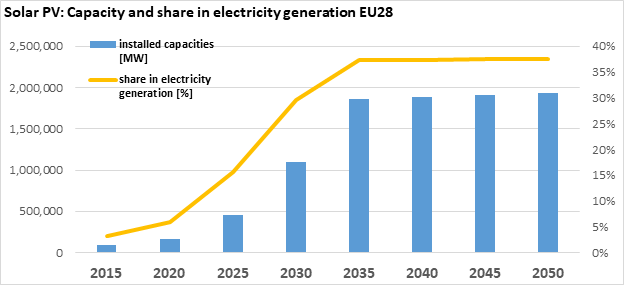
Solar prosumers become an important player in terms of balancing the grid. Their battery storage allows to shave peak load and ease the grids through self-consumption. The electricity market modelling with PAC scenario figures integrates 348 gigawatt of solar battery capacity with 100 TWh of solar electricity stored in 2030. Roughly half of the installed capacities are small-scale roof-top installations.
Renewing heat with ambient and geothermal energy
Heat pumps that capture ambient (aerothermal and shallow geothermal) energy quickly ramp up their energy supply from 25 TWh in 2015 to 497 TWh in 2030. They become the most important renewable energy supply for heating buildings in the residential and tertiary sectors after 2030, leaving solid biomass behind them. The PAC scenario follows the findings of the Heat Roadmap Europe 4, assuming that the heat pump potentials assessed in this research project can be fully mobilised.
Deep geothermal energy potentials in the PAC scenario are primarily mobilised through cogeneration. Geothermal heat mainly reaches consumers via district heat networks. Supply increases four times between 2015 and 2030.
Hydropower as reliable backup
Capacities of hydropower plants will not increase from 2020 onwards. The PAC scenario assumes that for environmental reasons, no new installations will be built. Climate change will affect water availability for hydropower. Depending on the temperature increase, hydropower production in Europe could go down by around 6% to 13%. In addition, pumped hydro storage keeps playing an important role for balancing electricity demand and supply (61 TWh stored and 44 TWh reinjected into the grid in 2030).
Securing an effective use of limited bioenergy carriers
In order to secure substantial climate benefits and avoid potentially harmful developments for ecosystems, the PAC scenario applies a number of sustainability criteria to bioenergy. Firstly, only waste and residues potentials are mobilised. Secondly, for reasons of efficiency, co-firing and electricity-only use is replaced by cogeneration. Inefficient individual wood stoves are gradually phased out. Thirdly, biomass is directed to those sectors where alternatives for decarbonisation are limited. Biomass is thus partly shifted to the chemicals industry which requires using it to substitute fossil oil as a non-energy feedstock for plastics.
So-called first generation biofuels produced with dedicated energy crops are phased-out by 2030. Second generation biofuels are limited to aviation and self-consumption in agriculture, for instance to fuel farming machinery that cannot be electrified. In this context, bioenergy is the only renewable energy source that clearly declines in the PAC scenario. Its primary energy supply drops by more than 60% between 2015 and 2050.
6. The PAC scenario, a living document
Civil society suggests the PAC scenario as a robust pathway to spur the EU’s climate action needed for living up to its own Paris Agreement commitments. It can at the same time be read as an investment guidance for the European Green Deal. A quick upscaling is possible. Growth rates are high, but technically achievable. The technologies needed are almost all ready for massive deployment. The PAC scenario shows EU leaders how to kick-start the green recovery. There is no need to wait for a miraculous medicine. The remedy is already in our hands.
The PAC scenario is published under an open license and invites for further exchange with energy experts and modellers. The series of PAC scenario workshops continues in the second half of 2020 to discuss further macro-economic findings, policy implications and reduction of non-energy related emission.
For further information about the PAC project consortium: www.pac-scenarios.eu or contact the author.

